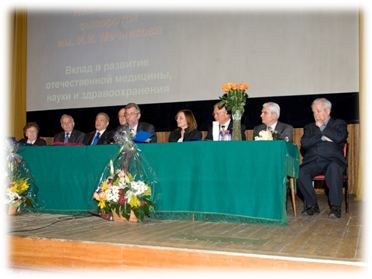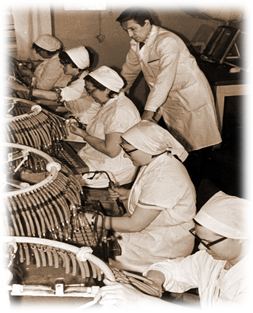Aimed at fighting louse borne typhus and other infectious diseases, the Institute was founded on February 23, 1919 according to the Decree of the Moscow Municipal Health Department Board. The Institute occupies the territory of one of the first Pasteur Stations in Russia, which was established in 1886.
The prominent bacteriologist L. Rosental was responsible for the establishment of the Institute. The Institute’s history is tied to the names of famous scientists who contributed to the development of Russian medical microbiology, virology, epidemiology, vaccinology and immunology, and who set up world-renowned scientific schools.

The history of the Institute is connected with the names of a lot of scientists: academicians — Lev A. Zilber, Lev V. Gromashevsky, Lia S. Stern, Vladimir D. Soloviev, Antonina K. Shubladze, Otar G. Andzhaparidze, Vitaly V. Zverev; professors Osip G. Birger, Alexander I. Savateev, German V. Epstein, Fedor G. Berngoff, Varvara A. Krestovnikova, Sofia I. Ginzburg-Kalinina, Svetlana S. Marennikova, Vladimir P. Efroimson, Midat A. Selimov, Angelina A.Varfolomeeva, Tagir A. Bektimirov, Evgenia A. Petrosyan, Alexander V. Kalyaev, Fridrih T. Grinbaum, Mira A. Frolova, Irina V. Golubeva, Vera P. Raginskaya, Mikhail I. Mikhailov, Nikolay N. Filatov, Oxana A. Svitich, Natalia A. Khomenko, Boris M. Raskin, Ludmila A. Levina, Nadezhda B. Egorova.
Directors of the Institute were:
- Vasily A. Novoselsky (1919-1923)
- Stepan V. Korshun (1923-1930)
- Mikhail S. Shamov (1930-1934)
- Semen L. Livshitz (1934-1937)
- Andrey P. Muzichenko (1937-1944, 1954-1960)
- Lev G.Veber (1944-1950)
- Mikhail I. Sokolov (1951-1954)
- Antonina N. Meshalova (1960-1965)
- Ivan F. Mikhailov (1965-1968)
- Asat H. Kanchurin (1968-1974)
- Boris F. Semenov (1974-2005)
- Vitaly V. Zverev (2006 — 2018)
- Oxana A. Svitich (2018 — to the present day)
For more than 30 years (1974-2005) Boris F. Semenov was the director of the Institute. Professor, Full Member of RAMS, Honored Scientist, Full Member of the International Academy of Sciences, he is famous for his research on vaccinology, immunopathology and immunology of viral and bacterial infections.
Due to reorganization in 2005 Research Institute for Viral Products of RAMS, which in 1999 was named after Otar Andzhaparidze, a prominent virologist, Full Member of RAMS and irreplaceable chief over 40 years, was joined to the Institute.
Since that moment until 2018 Vitaly Zverev, who is leading scientist in the fields of molecular biology, genetics, medical virology, immunoengineering and winner of Government award in science and technology, had headed the Institute.
 In 100 years of its existence, the Institute underwent a great history. Its name and structure changed many times due to assigned mission. In its early years, the Institute was strongly focused on the problem of louse-borne typhus elimination. In the mid-1920s, the Institute produced various vaccines, sera and drugs for the diagnosis of infectious diseases. In the 1930s, virological studies were conducted under the supervision of Lev Zilber. During the Second World War, the mass production of desperately needed drugs was organized (by that time the Institute had made 83products).
In 100 years of its existence, the Institute underwent a great history. Its name and structure changed many times due to assigned mission. In its early years, the Institute was strongly focused on the problem of louse-borne typhus elimination. In the mid-1920s, the Institute produced various vaccines, sera and drugs for the diagnosis of infectious diseases. In the 1930s, virological studies were conducted under the supervision of Lev Zilber. During the Second World War, the mass production of desperately needed drugs was organized (by that time the Institute had made 83products).
In the postwar period the Institute became a leading research center for vaccinology, microbiology, immunology and virology. On the basis of the Institute there have been established major scientific centers: the Central Research Institute for Epidemiology, OJSC «Biomed» (production of anti-bacterial drugs), the I. Mechnikov Ufa Research Institute for Vaccines and Sera (SPA «Immunopreparat»), and the Research Institute for Viral Products.
Scientific Activities
The Institute’s priority research areas are medical microbiology, virology, immunology, biotechnology and epidemiology. They aimed to include:

- Development of new products for vaccines, immunotherapeutic drugs, and improvement of the National Program on Immunization;
- Method development of managing innate immunity functions in order to support immunization against bacterial and viral infections, allergies, autoimmune diseases, and malignant growth;
- Innovative molecular technologies development for personalized diagnosis, prediction and treatment of allergic, immune and infectious diseases;
- Research into the molecular-biological pathogenicity and adaptive variability of viruses and bacteria. Investigations of causative agents` persistence and attenuation and naturally developed immunity against them;
- Development of new generation immune-and-biological products for the diagnosis of infectious diseases, allergies, autoimmune and endocrine disorders;
- Development of safe vaccines for the immunization of children with health concerns and chronic disorders
- Research and development of drugs for prevention and elimination of bioterrorism consequences and infections caused by unknown pathogens;
- Enhanced epidemiological surveillance of socially significant diseases.

Scientific Achievements
As already mentioned above, during the early years the Institute was focused on the problem of louse-borne typhus elimination. Then it produced various vaccines, sera and drugs for the diagnosis of infectious diseases. In the 1930s virological studies were conducted. During the Second World War the mass production of desperately needed drugs was organized, including the NIISI polyvalent vaccine (against tetanus, typhoid and paratyphoid fever).
In the mid 1950’s within a short period of time the Research Institute for Viral Products, based on the Institute’s Virology Unit, developed technology for the mass production of the first domestic polio vaccine. 43 million doses of vaccine were produced and 8 million children were vaccinated, thus leading to a rapid decline of morbidity. These vaccines were then exported to many countries such as Japan, Iran, Romania, Cuba, and China.
The Institute contributed to the eradication of smallpox by participating in the WHO’s global program for the eradication of this severe disease. The Institute provided the know-how for regular production of a highly active, thermostable, dry smallpox vaccine. 1.5 billion doses of this vaccine, considered second to none in the world, were produced by the Institute and were donated to the WHO. Vaccination with the Russian vaccine helped to eradicate smallpox in 40 countries of Africa and Asia. Many Institute`s scientists (O.G. Andzhaparidze, V.F. Bulk, S.S. Marennikova, N.N. Maltseva, E.M. Sheluhina) were awarded for the active participation in successful smallpox eradication.
Another crucial area of the Institute’s scientific work was research into the improvement of measles and mumps vaccines. Industrial strains of measles and mumps viruses were harvested, and vaccine manufacturing technologies of international standard were developed. When compared to pre-vaccination statistics of these diseases, vaccination has reduced the incidence of measles to 0.11 per 100,000 people and mumps to 1.31 per 100,000 people.
The Institute provided theoretical and practical grounds for the development of the cold-adapted influenza virus vaccine; it also refined live recombinant influenza A and B virus vaccines. It should be noted, that almost all russian virus vaccines were produced at Research Institute for Viral Products of RAMS.
In the early 1980s the Institute had become one of the leaders in medical biotechnology. The work of our scientists in restriction enzymes production has been recognized with the USSR’s Council of Ministers Prize.
Over time the Institute has developed and introduced into production a variety of immune-and-biological products, such as:
- inactivated polio vaccine;
- tick-borne encephalitis tissue vaccine;
- dermal live and inactivated smallpox vaccines;
- live flu (intranasal and oral) vaccines;
- rabies vaccines (3 types);
- measles vaccine;
- mumps vaccine;
- bivalent measles-mumps vaccine;
- olm vaccine (immunization of donors and immunotherapy of suppurative-septic infections);
- «Tomicid» (therapy of streptococcal and staphylococcal infections);
- «Affinoleukin» (immunocorrecting therapy);
- preparations for the diagnosis and immunotherapy of mite allergies;
- preparations for the diagnosis of food-borne, domestic and epidermal allergens;
- differential-diagnostic nutrient media.
The Institute has also developed and improved more than 150 preparations and substances for the diagnosis of:
- infections caused by smallpox, rabies, tick-borne encephalitis, measles, rubella, mumps, hepatitis B, C and E, influenza, herpes, cytomegalovirus, and HIV viruses;
- bacterial infections (staphylococcal, pneumococcal, diphtherial, tetanoid, syphilitic, and chlamydial);
- allergic, autoimmune, cardiovascular, and endocrine diseases;
- Enterobacteria (serologic identification).
In 1985 the Institute was the first to start intensive research into HIV/AIDS detection; by the middle of 1986 the first Russian test kits for screening and confirmation of HIV infection had been developed.
A bank of monoclonal antibody producers to antigens including high-consequence pathogens was created.
Modern medicine is aimed at developing of vaccines against socially significant infectious diseases.
Nowadays the Institute’s priority research areas include development of new products for vaccines and drugs and improvement of the National Program on Immunization. This is expected to reduce children`s morbidity and mortality. Thereby scientists continue to work at the development of:
- Pneumococcus vaccine based on domestic serotypes;
- tetravalent measles-mumps-rubella-varicella vaccine;
- Haemophilus influenzae vaccine;
- Rotavirus vaccine.
Scientists also investigate phagotherapeutical drugs in order to treat infections caused by antibiotic-resistant strains.
The Institute is involved in realization of Federal targeted scientific and technical programs, Russian Science Foundation and Russian Foundation for Basic Research grants, international grants.
Scientific achievements:
- Polycomponent vaccine («Immunovak-VP4») with well-established immunomodulatory functions was designed. The «Immunovak-VP4» vaccine activates the effector mechanism of the host’s innate and adaptive immune system. It has proven to be highly effective in the treatment of chronic inflammatory respiratory diseases, allergies, herpes virus infections, and in the prevention of acute respiratory diseases.
- The Institute has also developed the technology of cell-free pertussis vaccine and staphylococcal vaccine, which is able to stave off the infection.
- A monocomponent live tissue-culture vaccine was developed from domestic attenuated Varicella zoster strains for personalized prevention of chickenpox in children and herpes zoster in adults.
- Vaccines for the prevention of Pseudomonas aeruginosa infection based on hybrid recombinant proteins have been made.
- ARVI-screen kit «ARVI-Monitor» was developed for detection of the main human respiratory pathogens in nucleic acids and for epidemiological monitoring.
- Diagnosticums for determination of antibiotics (macrolides, glycopeptides, aminoglycosides and fluoroquinolones) were produced in order to carry out quality control of nutrition products and ecological monitoring.
- Sublingual granular forms of house dust mite allergen were designed for allergen-specific immunotherapy.
- A method for producing attenuated strains of influenza A virus candidates for live influenza vaccines based on a reverse genetics technology was found. The use of site-specific mutagenesis technology allows modifying the virulent strain genome and obtaining attenuated variants of the influenza virus with unique properties: in contrast to reassortant strains, they provide full protection against influenza infection amid low or absent reactogenicity.
